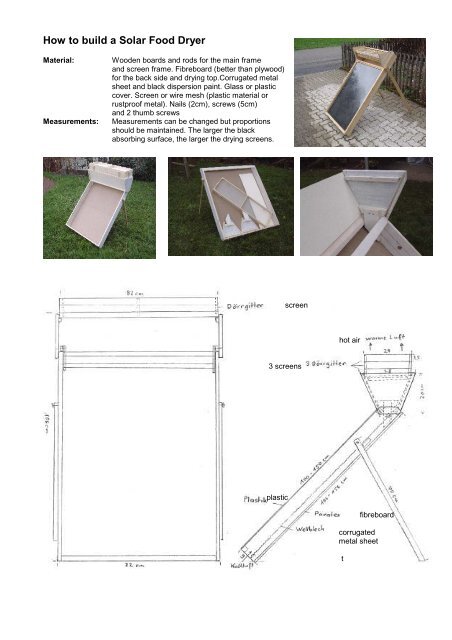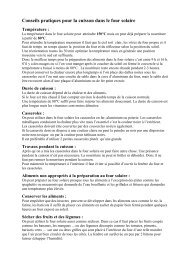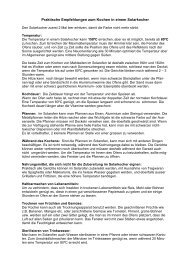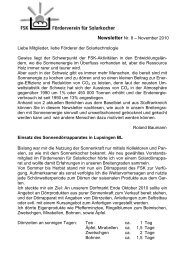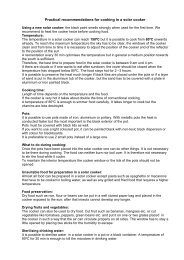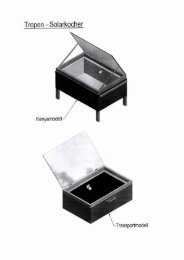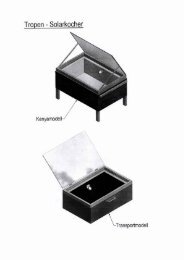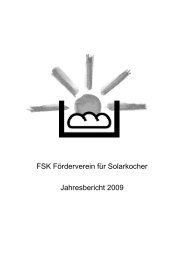DIY Solar Food Dryer - Military Hunting & Fishing
DIY Solar Food Dryer - Military Hunting & Fishing
DIY Solar Food Dryer - Military Hunting & Fishing
You also want an ePaper? Increase the reach of your titles
YUMPU automatically turns print PDFs into web optimized ePapers that Google loves.
How to build a <strong>Solar</strong> <strong>Food</strong> <strong>Dryer</strong>Material:Measurements:Wooden boards and rods for the main frameand screen frame. Fibreboard (better than plywood)for the back side and drying top.Corrugated metalsheet and black dispersion paint. Glass or plasticcover. Screen or wire mesh (plastic material orrustproof metal). Nails (2cm), screws (5cm)and 2 thumb screwsMeasurements can be changed but proportionsshould be maintained. The larger the blackabsorbing surface, the larger the drying screens.screenhot air3 screensplasticfibreboardcorrugatedmetal sheett
<strong>Solar</strong> <strong>Food</strong> <strong>Dryer</strong>Basic PrincipleA solar food dryer consists of a flat box (frame) placed at an angle, with an open bottom and top, sothat the air can circulate. Corrugated metal sheet, painted black, is placed on the bottom of the box.The black colour absorbs the sun rays and heats the air above. The frame is covered with glass,transparent plastic foil or a plain garden plastic. The warm air reaches 40 - 50°C, rises and leavesthe heating box through the top opening and flows through the drying chamber with the dryingscreens. Cool environment air is sucked off through the bottom opening.The dryer’s angle must be adapted to the respective geographical latitude: In Europe steeper (60°),and in the tropics flatter (30°). With a flat angle, air circulation can be improved by adding a chimney.The solar dryer only works with direct solar radiation and works best during dry periods when thereis little humidity in the air.How to dry with solar energyWhy dry? To dry with warm and dry air is the easiest and cheapest conserving method. A solardryer can considerably speed up this process. A solar cooker can also be used to dry food; to do sothe cover must not be closed completely.The warm air draws water from fresh food and thus conserves it without destroying vitamins andwithout affecting the nutrient content.What can be dried?The solar dryer is suitable for tomatoes, bananas, mangos, apples, plums, tea, fish etc.How to dry?<strong>Food</strong> to be dried is cut in halves or slices or shredded and placed on the screens. Fruit should notbe too ripe and juicy to avoid dripping. Dry the tea leaves without very large stems.Drying timeThe length of time with any drying procedure depends on the water content of the food, thetemperature and the humidity in the air. Tea leaves only need a few hours but tomatoes and fruitmay take several days to dry. The interruption of the drying process at night is an advantagebecause fast drying produces crusts that obstruct a further withdrawal of water. Any crusts aretherefore soaked during the night and the next day the drying process can go on unhindered.Cover<strong>Food</strong> should not be exposed directly to the sun because it changes its colour. Therefore, the topdrying screen should be covered with an empty screen or a lid with holes, keeping off flies at thesame time.Position of the dryerIt is not necessary to direct the solar dryer in the course of the day to the changing position of thesun. It is good enough to place it according to the highest position of the sun at midday.DurabilityDried food keeps for several years if stored in an airtight container (plastic bag or glass screwedtightly). <strong>Food</strong> kept in the open or in a container not closed tightly, will absorb the humidity in the airso that mould, putrefactive bacteria or insects can destroy the food.


